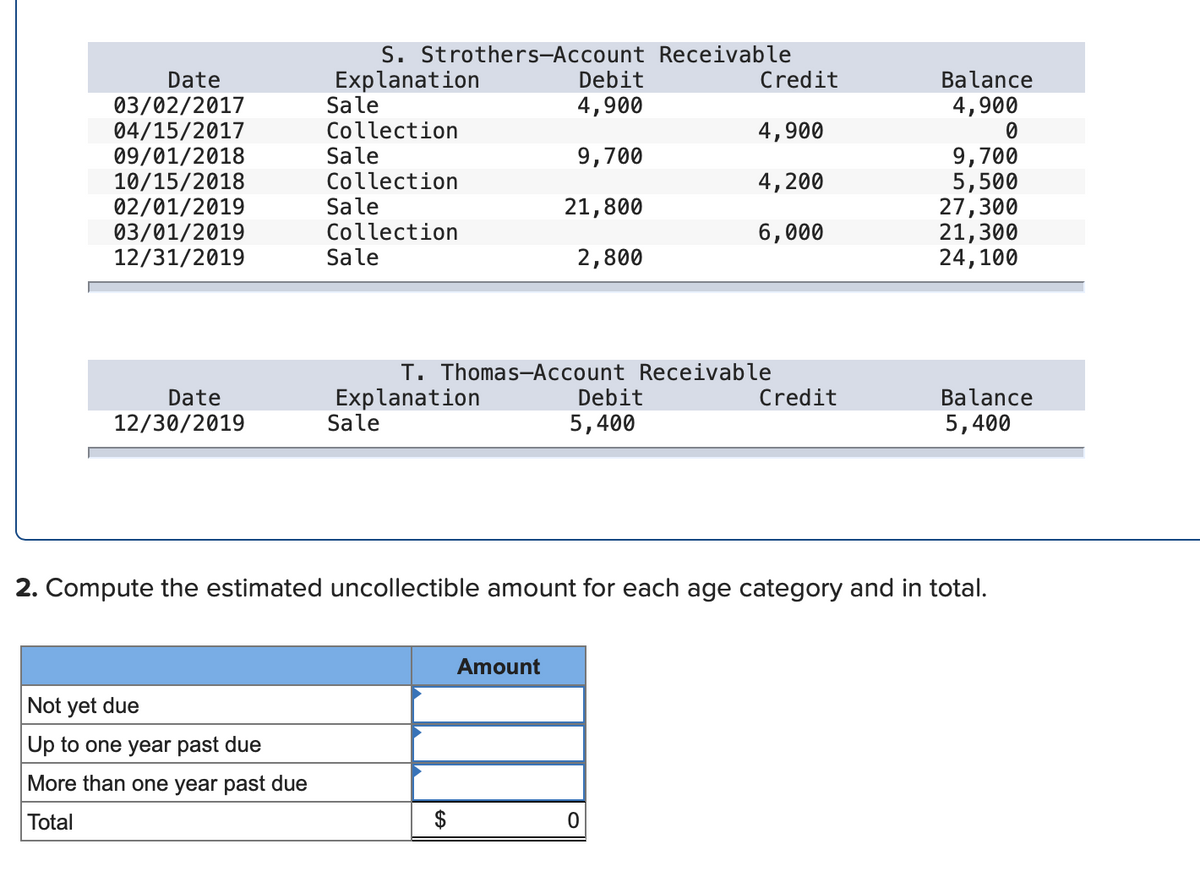2. Compute the estimated uncollectible amount for each age category and in total. Amount Not yet due Up to one year past due More than one year past due Total $
2. Compute the estimated uncollectible amount for each age category and in total. Amount Not yet due Up to one year past due More than one year past due Total $
Cornerstones of Financial Accounting
4th Edition
ISBN:9781337690881
Author:Jay Rich, Jeff Jones
Publisher:Jay Rich, Jeff Jones
Chapter5: Sales And Receivables
Section: Chapter Questions
Problem 85APSA: Determining Bad Debt Expense Using the Aging Method At the beginning of the year, Tennyson Auto...
Related questions
Question
Please answer the question. I provided two picture's so I do not have to type out everything!

Transcribed Image Text:S. Strothers-Account Receivable
Debit
4,900
Explanation
Sale
Collection
Sale
Collection
Sale
Collection
Sale
Date
Credit
Balance
03/02/2017
04/15/2017
09/01/2018
10/15/2018
02/01/2019
03/01/2019
12/31/2019
4,900
4,900
9,700
5,500
27,300
21,300
24,100
9,700
4,200
21,800
6,000
2,800
T. Thomas-Account Receivable
Explanation
Date
Debit
Credit
Balance
12/30/2019
Sale
5,400
5,400
2. Compute the estimated uncollectible amount for each age category and in total.
Amount
Not yet due
Up to one year past due
More than one year past due
Total
2$
![Required information
[The following information applies to the questions displayed below.]
Blue Skies Equipment Company uses the aging approach to estimate bad debt expense at the end of each accounting
year. Credit sales occur frequently on terms n/60. The balance of each account receivable is aged on the basis of three
time periods as follows: (1) not yet due, (2) up to one year past due, and (3) more than one year past due. Experience has
shown that for each age group, the average loss rate on the amount of the receivable at year-end due to uncollectibility is
(a) 4 percent, (b) 13 percent, and (c) 31 percent, respectively.
At December 31, 2019 (end of the current accounting year), the Accounts Receivable balance was $51,300 and the
Allowance for Doubtful Accounts balance was $1,090 (credit). In determining which accounts have been paid, the
company applies collections to the oldest sales first. To simplify, only five customer accounts are used; the details of each
on December 31, 2019, follow:
B. Brown-Account Receivable
Debit
Explanation
Sale
Collection
Collection
Date
Credit
Balance
03/11/2018
06/30/2018
01/31/2019
14,300
11,100
6,500
14,300
3,200
4,600
D. Donalds-Account Receivable
Explanation
Sale
Collection
Collection
Date
Debit
Credit
Balance
02/28/2019
04/15/2019
11/30/2019
22,100
13,400
8,700
22,100
8,700
4,700
N. Napier-Account Receivable
Explanation
Sale
Collection
Date
Debit
Credit
Balance
11/30/2019
12/15/2019
8,800
8,800
6,600
2,200](/v2/_next/image?url=https%3A%2F%2Fcontent.bartleby.com%2Fqna-images%2Fquestion%2F7850c6f7-b79b-434d-9395-5e8ad7952f99%2Ff65abe58-5659-4200-8390-f4680f8cdf37%2Fom5sn9w_processed.png&w=3840&q=75)
Transcribed Image Text:Required information
[The following information applies to the questions displayed below.]
Blue Skies Equipment Company uses the aging approach to estimate bad debt expense at the end of each accounting
year. Credit sales occur frequently on terms n/60. The balance of each account receivable is aged on the basis of three
time periods as follows: (1) not yet due, (2) up to one year past due, and (3) more than one year past due. Experience has
shown that for each age group, the average loss rate on the amount of the receivable at year-end due to uncollectibility is
(a) 4 percent, (b) 13 percent, and (c) 31 percent, respectively.
At December 31, 2019 (end of the current accounting year), the Accounts Receivable balance was $51,300 and the
Allowance for Doubtful Accounts balance was $1,090 (credit). In determining which accounts have been paid, the
company applies collections to the oldest sales first. To simplify, only five customer accounts are used; the details of each
on December 31, 2019, follow:
B. Brown-Account Receivable
Debit
Explanation
Sale
Collection
Collection
Date
Credit
Balance
03/11/2018
06/30/2018
01/31/2019
14,300
11,100
6,500
14,300
3,200
4,600
D. Donalds-Account Receivable
Explanation
Sale
Collection
Collection
Date
Debit
Credit
Balance
02/28/2019
04/15/2019
11/30/2019
22,100
13,400
8,700
22,100
8,700
4,700
N. Napier-Account Receivable
Explanation
Sale
Collection
Date
Debit
Credit
Balance
11/30/2019
12/15/2019
8,800
8,800
6,600
2,200
Expert Solution
This question has been solved!
Explore an expertly crafted, step-by-step solution for a thorough understanding of key concepts.
This is a popular solution!
Trending now
This is a popular solution!
Step by step
Solved in 2 steps with 2 images

Knowledge Booster
Learn more about
Need a deep-dive on the concept behind this application? Look no further. Learn more about this topic, accounting and related others by exploring similar questions and additional content below.Recommended textbooks for you

Cornerstones of Financial Accounting
Accounting
ISBN:
9781337690881
Author:
Jay Rich, Jeff Jones
Publisher:
Cengage Learning

Principles of Accounting Volume 1
Accounting
ISBN:
9781947172685
Author:
OpenStax
Publisher:
OpenStax College


Cornerstones of Financial Accounting
Accounting
ISBN:
9781337690881
Author:
Jay Rich, Jeff Jones
Publisher:
Cengage Learning

Principles of Accounting Volume 1
Accounting
ISBN:
9781947172685
Author:
OpenStax
Publisher:
OpenStax College


College Accounting, Chapters 1-27
Accounting
ISBN:
9781337794756
Author:
HEINTZ, James A.
Publisher:
Cengage Learning,


Intermediate Accounting: Reporting And Analysis
Accounting
ISBN:
9781337788281
Author:
James M. Wahlen, Jefferson P. Jones, Donald Pagach
Publisher:
Cengage Learning